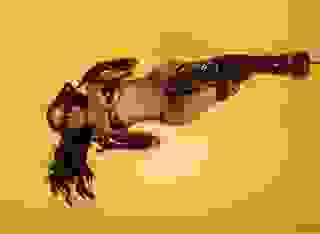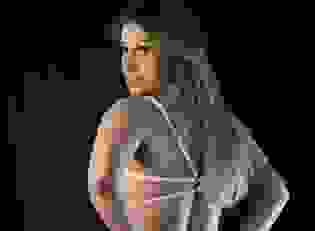Note: You can change font size, font face, and turn on dark mode by clicking the "A" icon tab in the Story Info Box.
You can temporarily switch back to a Classic Literotica® experience during our ongoing public Beta testing. Please consider leaving feedback on issues you experience or suggest improvements.
Click here"Jennifer, William, come to command," Micks said standing in the module hatch. "Starlink lost its fix on Scoope 1 just now. I came back here right away. Wheels is running diagnostics across all systems."
"We have a link now?" Jennifer said.
"Yes, we're still running the pattern. We're on slice 67."
"We should stop," Jennifer said, fumbling to get out of her sleep pod, knocking her head on the bulkhead in the process. She rubbed her head.
"There's no error. Drone systems check out. All logs agree there was no malfunction of scan or Starlink," Wheels said from his pilot's chair in command as Jennifer walked through the entrance.
"John, who's up over there?" Jennifer said over comms.
"We're both here. Let's assume we happened to catch an edge of the void particle mass. I propose we perform a direct translation to slice 72 and reverse the pass direction. If our friend's artificial brain estimates of volume are close, this should put us where the distribution is uniform," John said.
"I Agree," said Jennifer.
The ship rolled and yawed, reversing its main thrust axis 180 degrees while keeping the Whipple shields facing each other. Dorsal maneuvering thrusters elevated them to slice 72, where they resumed main axis motion, starting the search pass in the opposite direction. There was a flash, a yellow alert message: Starlink navigation fix lost. It was displayed on every console, at every station. Losing celestial navigation locks was not desirable and the system designers really wanted to make sure you were aware of this. In this case, the reference point was marked as low-priority. It was not part of the navigation kernel.
Jennifer hunched over her terminal, and her pulse rose. She double-checked the Starlink error message.
"Pattern stop!" Jennifer said.
"Acknowledged, pattern stopped," replied John.
"John, prepare the boundary trace program. If this is the void matter interdicting our laser, this will map its shape out. The program will begin moving the laser beam until it can see the reflection again."
"Boundary trace program running," John said.
"The mass is large, more than I expected. The drone can see you, John, from its position; however, I'm getting no reflections from your Whipple Shield, at all. This gives us rough volume, and velocity. I'm repositioning the drone for communications duty now. Direct line comms between us won't work, obviously, if the void particle mass sits between us."
"You said you thought this stuff allowed normal, baryonic matter to pass right through it? What happens if we brush up against it?" Micks said.
"Nothing, I hope. All I'm willing to say at this point is anything with a mass greater than hydrogen is ignored. It might interact with electrons. It could be these particles are quite common, if the density were low enough in free space, they'd be hard to find. Imagine dark matter that didn't interact with gravity.
I want to get closer. I want to charge the Whipple shields and conduct magnetic and electric field experiments. What do you think Micks?" Jennifer said.
"I'm not going to get in the way of science, I'm intrigued. Concerned, but intrigued," Micks replied.
"Take us in, 100 meters of Scoope 1, if you're willing," Jennifer said.
"Disengaging navigation slave, taking us in," she said, activating thrusters to guide ISS328 closer to Scoope 1.
"No magnetic, no electric, no radiation, same as before," John said.
"That's crazy, you're telling me we can bombard this thing with radiation and it still registers like empty space, like cosmic background radiation? Where does the energy go? What about conservation and symmetry and all that?" Tad said.
"It has some of the properties of a black body -- an idealized mass that absorbs all electromagnetic radiation it comes into contact with. It just doesn't radiate anything back. It may be the energy is transduced into something we're not measuring, perhaps because we don't know how," William said.
"100 meters," Micks said.
"Jesus, you're almost in that stuff, according to the scans from the drone," John said.
"Go to 50," Jennifer said.
Micks's eyebrows curled in concern, but she didn't say anything as she operated the navigation controls.
"50 meters. Now what?" Micks said, pursing her lower lip. Wheels stared at the port's external observation monitor. "It's ... very dark out there," he said "You push us any closer to that you're going to have real Starlink failures. The twins will have a damn fit," Wheels said.
"I agree." Micks said. "Switch on LGG and inertial guidance. Keep an eye on gyro drift. I don't want to get out of synch this close to another ship."
"Laser gyroscopic guidance won't save us if were in the soup too long," Wheels mumbled.
"I want to run magnetic probe tests. Can we go to 40?" Jennifer asked.
"What the fuck?" Micks said. She exchanged a look with wheels, the look of a pilot and copilot that had flown together before. The dura-vinyl in her seat squeaked as she shifted her weight. No one said anything when she operated the controls.
Alert lights flashed on the consoles. Alarms sounded. The guidance computer twins were having a fit, and they made sure it was a good one: "Starlink primary kernel failure! Navigation failure! Starlink primary kernel backup failure! Navigation Failure!"
The panicked voices looped continuously, in parallel, with another voice droning in full competition. "LGG guidance failover! Check Starlink! LGG guidance failover! Check Starlink! LGG guidance failover! Check Starlink ..."
"I gotta be honest, I don't think I've ever heard the twins this pissed ... ever," Wheels said. "What do we do now?"
"Can we select alternate fix points?" Micks said with a raised voice over the din.
Wheels swiped screens on the console next to him. Star charts flashed in succession on the monitors to his left and right. "Negative. Guidance kernel would be insufficient. I'll silence the alarms. LGG, and inertial are now primary guidance. You're deep in the soup now," Wheels replied, with a smirk. "I told you this would happen."
Jennifer's head was inches from the science control panels, "I can't tell anything from the probe. Field strength seems uniform. I saw a few fluctuations that looked like inductive feedback when I was running waveforms through it. Part of me wanted to find something crazy, like a magnetic monopole. Still, I'm collecting more data than we had available before. Maybe the science staff at CoreX can review it, spot something I missed."
"Don't give up on fame and riches yet," John said over comms.
"How is it we still have comms?" Wheels said.
"Aft of the ship is still out of the soup by my estimation. We're able to bounce off the drone, that's why we brought it," Jennifer replied. "How close, within safety margins, could we get with inertial guidance to Scoope 1?"
"Sprouted some hairs down there huh girl? Too bad you didn't have those earlier," Micks groaned. "I don't like it. Me? I'd say twelve meters. Smashing a few thousand metric tons of metal together in the middle of nothing, surrounded by stuff that may eat your distress signal is a really bad idea in my book of piloting," Micks said.
"There's one more thing," Jennifer said. "In addition to close formation navigation, we'll need to couple our power systems with an external link."
"What?" Micks said.
"Maybe I didn't explain this experiment very well. I want to get the Whipple shields close enough to set up an electric field. I'll need charge on both sides. We can couple them using the robot arms, can't we?" Jennifer said.
Micks ran her hands up and down her face. "I should have asked more questions. What the fuck did I sign up for here?" she steepled her hands, thumbs under her chin, fingers pointing below her nose. Her gaze alternated between the module ceiling, the quiet but still blinking Starlink navigation error icon, and her own fingers.
"Wheels?" she said, finally looking at him.
"Don't look at me. You're the boss on this ship," he said.
"For God's sake. Negative aft thrust, 100 LGG relative," Micks said.
Both ships moved backward. They rolled dorsal to dorsal to perform the reactor cross-link. Micks brought up the cargo arm control from the command module. The cable was a magnetically coupled device. It was the space equivalent of what atmospheric craft used for in-flight refueling.
"That looks pretty close 328, I'm going to try for maglock on the coupler ..." Micks said.
"Got it! Current loop is good. Nice flying," John said.
With a common power supply, they could generate an electric field between the two Whipple shields. What would the permittivity constant Jennifer wondered? If it ignores electric fields, like everything else, it will be the same as a vacuum.
"Can we use the data link over the power conduit for communications now, just in case?" Wheels said?
"I don't see why not," John replied.
"Ok, do it. Then give us a RCS bursts and we'll ride the inertia in, when Miss Faraday here says stop, we'll stop," Micks said.
Both ships moved forward, toward the void particle phenomena on a short forward thrust. Jennifer opened new control screens on her console. "John, Increase the plate voltage but stay under the upper KeV bound. These shields are fiber metallic laminate, over that, and we'll probably melt the metal."
Gauges rose on her linked display.
"That's unfortunate, I'm getting arcing here, hold up. Let me see if I can adjust the insulation distance from the aux sensor tower remotely," Jennifer said.
"We're passing the lower keV bound," John said.
"Communications failure with the drone," Wheels said.
Micks was quick. "Shut down power! Fuck." She started a checklist from memory.
"Comms checklist:
comms bus power - check
comms antenna array power - check
comms aft low gain antenna reflection test- check
comms high gain dish - lock lost
We're losing the signal lock. That doesn't make any sense. I'm asking it to search and re-acquire the communication dish alignments. I don't see why we would need that, we're not moving."
"Maybe blame the inertial guidance. You think you're not moving, but how can we tell without Starlink?" Wheels said.
"High gain synch re-established. High bit-rate band restored. Ok. You can try your toy again," Micks said.
John started ramping the electric field between the Whipple plates.
"Comm failure! Again!" Micks said. "Shut it down. The system just rebooted, with a check-failed error."
"What exactly is that?" Jennifer asked.
"It's a system error that shouldn't be possible. The computer assumes something crazy has happened, a cosmic particle flipped a bit, hardware failure, etc. Its best shot is to reboot. I'm checking the logs."
Micks scrolled through bizarre screens, diagnostics, and long lines of text. Her brow furrowed as she went deeper through nested screens and text. Sixteen screens later, she announced her findings.
"It's a packet time framing error. Every packet we send has a timestamp. The round-trip times are logged and correlated with the navigation systems. It even takes general relativity into account, like planetary GPS systems, for when we are running high G burns. If there is lensing due to a star, or a time dilation effect taking place due to high relative motions, the system is aware of them. Here's the catch though, our combined inertial reference frame should be static. We're not moving with respect to each other.
If I had to guess, and this is a guess, I'd say we experienced some inertial movement that the system wasn't aware of -- unlikely unless someone came along and gave us a shove -- or something lensed our comms beam, also unlikely, as anything with enough gravity to do that would pull our ass into it."
Micks leaned back. As stern as she'd been earlier, she looked curious now. "Hmmm. The first error was an antenna alignment error. That shouldn't happen, we're not moving with respect to each other. These systems are expert at maintaining high gain antenna alignment, nearly flawless, and that's why the second error makes even less sense. The amount of displacement to cause a timing error, hell, you'd think we'd feel that in our damn seat cushions. You'd have to move faster than those little servo motors in the comms dishes could anticipate."
"You're saying if we didn't move, then something bent the signal on the way to and from the drone, that it takes longer to travel a curved path?" William asked incredulously.
"Every packet has a timestamp suffixed with a monotonically increasing number. We know the speed of transmission and the distance. The timestamps are there to handle double-path signal returns, reflections, etc. It makes sure we are reassembling the data in the correct order. For example, if I get a signal reflection that arrives later than the primary signal, the timestamp allows the system to discard that reflected packet. It knows it already processed that data. These computer timestamps don't match the known distance to the transmitter."
"Could we try one more time, can we look at diagnostics while it's happening, or will it just crash?" Jennifer asked.
"Maybe. We can try it. I'll allow it run a little while," Micks said.
John engaged the electric field again.
"Same failure, hang on, I'm looking ... the signal ... it is being stretched," she said
"But how?" William said.
"Leave it on for a bit," Micks said, furiously scrolling through comms debug logs while muted alarms flashed on her terminal.
"Master alarm! All Navigation failure! Master alarm!" the navigation thought model twins said direly.
"Holy fuck, that's all of them. LGG and Inertial have failed as well," Wheels said, throwing his arms up in the air.
"Shut down! Shut it all down now!" Micks barked.
"What the hell! We were moving, and not in a Newtonian way," Wheels said.
"We've got time-stretched comms signals, navigation computers that say we're moving, and no Starlink to verify what's happening to us for sure," Micks said. "None of this makes any sense."
Wheels was attempting to synchronize navigation by eyesight again using aft visual monitors.
"What is going on ISS328? We've had multiple comm failures with the drone and just had a navigation general alarm. If it wasn't for the physical cable link between the ships I'm not sure we'd be talking at all, and it's a lucky thing we haven't run into each other.
I'm synchronizing with Wheels using the aft monitors to make sure we don't have an accident out here but I need to know what's going on before we try that again," John said.
"I have an idea, but, it's bizarre. You'll want to lock me up," said Jennifer, earning all eyes and a quiet comm link.
"Can we have the drone record visual telemetry, or at least where it thinks we are, for a bit and review it after we sync again? I want to try one more time."
"There isn't a lot of onboard storage on the done, but we could," John said.
Micks twirled a tuft of her hair into what looked like a painful not. "Ya, I hear you idiots. Let me see that synch log you two just made from the aft monitors. If you can convince me we didn't just almost need a new paint job, I'll let you run this madness one more time. Just one more."
She reviewed the logs, then nodded. John engaged the electric field.
The master alarm fired as expected. The systems were shut down, and the drone telemetry was streamed over the monitors.
"328, are you seeing this? What the hell? Look at the halo around the edges of the Whipple shields from our navigation lights. It's fuzzy, but it was only there when you ran the electric field. It's some kind of lensing, but, if it's from gravity, I don't see how that's possible. I would expect the Laser Gyros to pick up something. I don't see anything in the logs I can detect," John said.
"We assume we need gravity to bend space because that's how we've always seen it done. What if this is more like a bubble sitting under a piece of vinyl? Like when you are trying to put a sticker on something, and there's that one air bubble you didn't get out. You can push it around all you want without disturbing the vinyl. If you are lucky maybe you can push it out the edge," Jennifer said.
"I just pop them with a pin, smash them flat," Wheels said.
"Ok, metaphors are always a little fragile. Imagine that bubble exists from somewhere else, it's not within your universe -- the plane of the vinyl sticker -- but you can, for example, push it around with your thumb," Jennifer said.
"That's a pretty out there theory. Why does this bending only occur under an electric field?" Micks asked.
"I don't know, but when it is under a field, I think we are pushing it around. That action, the bending, must be coming from somewhere outside our universe because there is nothing here that possesses the energy to perform that feat with the physics we understand," Jennifer said.
"We didn't move much, hardly measurable," Micks said.
A curious sound rang through the hull, like water boiling in a teapot, except imagine the water being liquid mercury, it was so brief Jennifer wondered if anyone else heard it.
"Did you hear something, some kind of weird sound," Wheels said?
"Maybe ... I-" Micks started to say, interrupted by comms.
"Scoope left, can you hear me guys? I just saw a flash of ... colors, that's the best I can describe it, out of my front monitors, which should be pointed at you. Mind you, they've been pitch black since we've been in this stuff. My radiation meters went off the chart," John said.
"We just picked up a burst of gamma radiation. I don't think it pentrated shielding, but where the hell did it come from?" Micks said
"LDR coolant loop one's pump is overspeed," Wheels said
"How is that possible," Micks said. "I know we were at 82% when we launched but that's not enough to cause cavitation. We're not even running the radiator at the moment. It should be in closed cycle."
"I've got some bad news. Either we just collided into Scoope 1, or whatever bizarre forces we've been playing with ripped a hole in the forward Liquid Droplet Radiator emitter," said Wheels.
"Scoope 1, did you register any collision?" Micks said.
"Negative scoope left."
"Damnit! Fuck this science experiment. And those bastards only loaded us to 82% LDR capacity at dry dock," Micks said in anger. If we leave now we may still be able to execute a minimum duration burn for home."
"What about the Whipple shields and all that crap we've got hanging off the sides of the ship?" Wheels said.
"The hell with it. Back us out of this soup, now!" Micks said.
"Scoope 1, once we're clear. Get some distance from us asap. I'm blowing the explosive decouple on the sensor towers. I suggest you do the same. We're leaving this stuff here. If MOTC wants to file an orbital trash report on us, so be it. We're calculating the nearest brachistochrone burn for Mars. You're on your own time schedule. This is Iss328 declaring emergency." Micks said.
"Iss328, acknowledge emergency, making clear for you. Micks, there's enough room for all of you here. We could return on Scoope 1, or apply for a slow transfer orbit," John said.
"We don't have the life support for a slow ride home. Negative on personnel transfer as well. I'm not Mary Celesting 328 out here to soil my record. I want to get as much speed as I can before I lose my cooling fluid. I'll make my secondary command decision once we're in motion."
"Acknowledge. We'll be on standby and attempt a parallel burn to you," John replied.
Micks opened a mechanical console door. She flipped arming switches and pulled an electro-mechanical relay. An explosive charge detonation rang through the hull. The two sensor towers and the Whipple shield drifted away, tangling into a clump of white and silver detritus.








